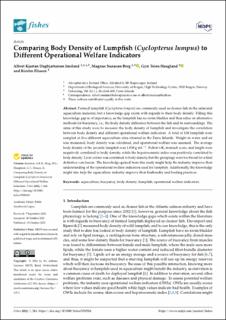Comparing Body Density of Lumpfish (Cyclopterus lumpus) to Different Operational Welfare Indicators
Journal article, Peer reviewed
Published version

Åpne
Permanent lenke
https://hdl.handle.net/11250/3031186Utgivelsesdato
2022Metadata
Vis full innførselSamlinger
- Department of Biological Sciences [2235]
- Registrations from Cristin [9791]
Sammendrag
Farmed lumpfish (Cyclopterus lumpus) are commonly used as cleaner fish in the salmonid aquaculture industry, but a knowledge gap exists with regards to their body density. Filling this knowledge gap is of importance, as the lumpfish has no swim bladder and thus relies on alternative methods for buoyancy, i.e., the body density difference between the fish and its surroundings. The aims of this study were to measure the body density of lumpfish and investigate the correlation between body density and different operational welfare indicators. A total of 138 lumpfish were sampled at five different aquaculture sites situated in the Faroe Islands. Weight in water and air was measured, body density was calculated, and operational welfare was assessed. The average body density of the juvenile lumpfish was 1.030 g mL−1. Fulton’s K, stomach score, and length were negatively correlated to body density, while the hepatosomatic index was positively correlated to body density. Liver colour was correlated to body density, but the groupings were too broad for a final definitive conclusion. The knowledge gained from this study might help the industry improve their understanding of the operational welfare indicators used for lumpfish. Additionally, the knowledge might also help the aquaculture industry improve their husbandry and feeding practices.
